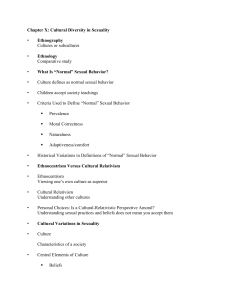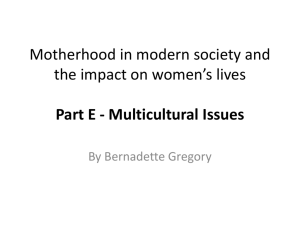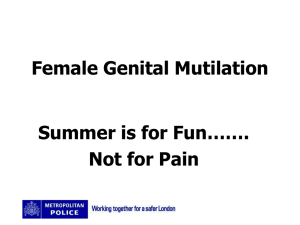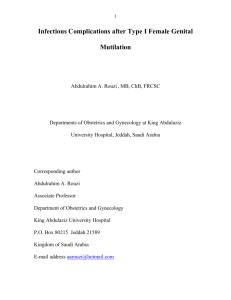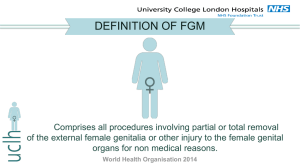Family Planning and Female Genital Mutilation: Honors Thesis (HONRS 499) An
advertisement
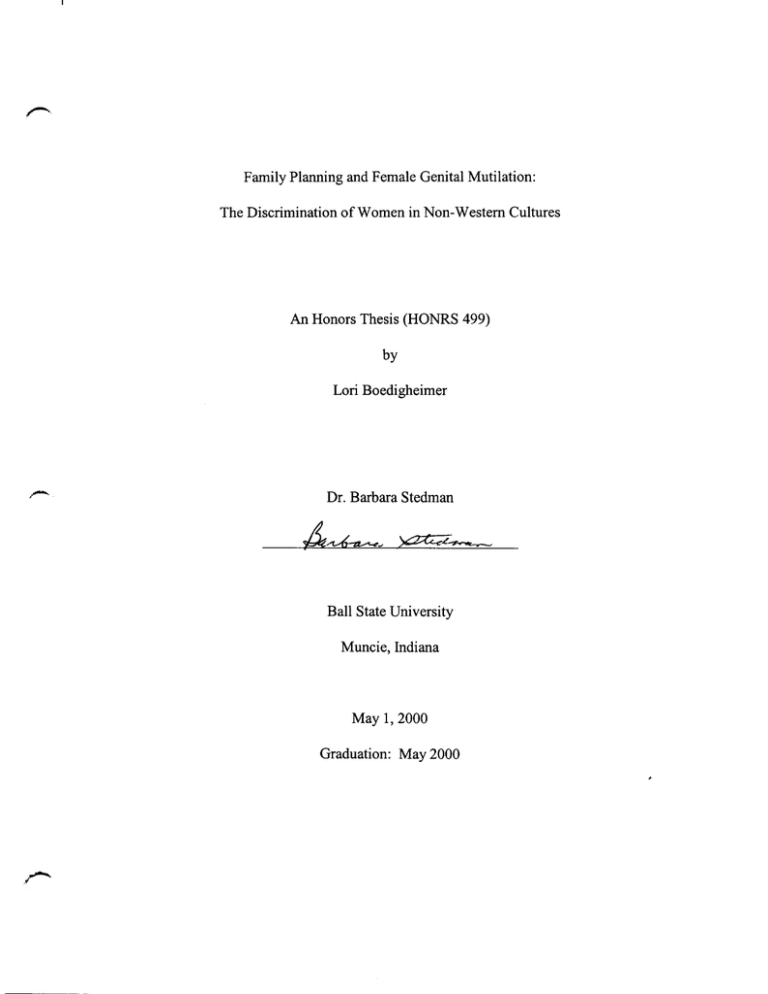
Family Planning and Female Genital Mutilation: The Discrimination of Women in Non-Western Cultures An Honors Thesis (HONRS 499) by Lori Boedigheimer Dr. Barbara Stedman Ball State University Muncie, Indiana May 1, 2000 Graduation: May 2000 SpCol/_ -;.!" C ,- ~ ;... 2 - Acknowledgments Thank you, Dr. Stedman, for your help and guidance, but most importantly for your patience as I took this journey they call an honors thesis. Thank you, Dad, for being there for my throughout my life and helping me to stand strong in the face of adversary. Thank you, Jill and Kim, for being my sisters and my friends. The most treasured role I have in life is that of a sister. - - 3 Abstract Within this paper, I explore the discrimination of women, focusing primarily on their health and sexuality. I seek to ascertain the different forms this discrimination takes, the cultures it is occurring in, and how it is affecting the women. The issues of family planning and female genital mutilation are studied within the context of non-Western cultures--specifically, India, China, and various African and/or Muslim societies. I attempt to understand the history and traditions of these cultures and how the women perceive the discrimination. I attempt to explore the two issues without bias from my own culture. I do not formulate solutions to the problem of discrimination. Nor do I in any way suggest that non-Western cultures are inferior to western cultures. Instead, I am simply discussing the issue of sexuality and its effects on the women. - 4 Table of Contents Introduction page 4 Family planning page 6 Female genital mutilation page 18 Conclusion page 29 References page 31 5 -. Introduction To discriminate is to "make a difference in the treatment or favor on a basis other than individual merit" (Merriam Webster's Collegiate Dictionary, 1994). Every day of our lives, almost unconsciously, we generalize groups of people based on similar characteristics such as race or gender. When we move from generalizing to making a judgment about what people want, need, and deserve, we are discriminating against them. Discrimination is denying a person hislher thoughts, feelings, and unique personality. People are discriminated against all over the world because of their race, age, religion, and socioeconomic status. The cruelty of discrimination is epitomized in racism, ageism, and sexism because these characteristics are unchangeable. When a person is born female she is immediately susceptible to unfair and unequal treatment from society. - Sexism dates back to biblical times, for Eve is considered responsible for the Fall of Man: "So she took some of its fruit and ate it. Then she gave some of it to her husband and he also ate it" (Genesis 3:6). Eve is blamed for one of the greatest insults given to God. Over the centuries women have been blamed for many things such as the temperament, sex, and disabilities of their children, their infertility, their unmarried state (a "spinster"), and the condition of their home. Anything that has gone wrong in the household has typically been attributed to the wife and mother. Society has always had high expectations of women. Though the concept of the perfect woman has changed, the ideals of elegance, style, gentility, culinary skills, and maternal instincts have remained. Though no women can possibly possess all these characteristics, every little girl wants to be the perfect wife and mother. But somewhere in the maturation process the dream of perfection shatters. Women begin to truly see 6 .- themselves and to have goals and values that don't meet society's expectations. And therein lies the problem. The gaping chasm between what women want to be and what society expects of them is the discrimination of women. This discrimination is alive and well today. In the United States our society has become politically correct. However, the discrimination remains, covert, but still present. In non-Western cultures the discrimination seems more blatant. While it appears obvious to the people outside of the countries, the non-western women themselves are accustomed to the discrimination. Unequal treatment is such a part of everyday life that the women themselves cannot truly see it. The discrimination of women is embedded into the laws, customs, and heritage of many non-Western societies. This unfair treatment takes the form of control when women are infants. From day one, - numerous aspects of women's lives are controlled by the government. They are purposely kept dependent on their husbands, sons, and fathers. Keeping women dependent means that they are powerless and will not be a threat to society. The reality is that many societies feel threatened by the potential power of women. A woman's sexuality is something men generally do not understand and cannot control. Therefore sexuality of women is particularly threatening to many societies. A consequence of this fear is the discrimination women feel in family planning, and female genital mutilation. 7 Family Planning At 1.2 billion, China contains one-fifth of the world's population (Richards, 1996). In India, the average birth rate is 27.4 as compared to the United States birth rate of 15.2 ("Thank God ... ,"1997 ). In both India and China, the overwhelming populations threaten nationwide hunger and the depletion of financial resources. Not surprisingly, China and India were among the first countries to develop national family planning strategies. The idea behind both countries' strategies was to decrease the rate of births so that the rest of the country could have the necessary food, housing, and resources it needed to prosper. The unintended significant consequence of the strategies of both countries, however, was that women do not have freedom of choice concerning their reproductive needs. The need to decrease the population is considered rather than the - needs of anyone woman. Essentially the needs of the country are coming before the needs of all the women who make up its population. This is the discrimination of women. In China, this discrimination has taken the form of genetic engineering and abortion. In India, one can see the discrimination in the sterilization and the use of intrauterine devices. In 1979, Dang Xiaping, then the leader of China, instituted the One Child Policy. The policy aimed to level out the population at 1.2 billion by 2000 and then to bring down the population to 700 million over the century. A series of incentives and penalties was created since there were no laws existing to monitor the number of children a couple could have. Preferential treatment was given to women pregnant with their first child. These women were given maternity leave for up to three years, a ten percent salary bonus, free health care, free education, and pensions after retirement. Financial penalties 8 -- and exclusion from benefits were the punishment for those who had a second child. In Central China, the penalty for the third child was thirty percent of the family's annual income for fourteen years (Richards, 1996). Before 1992, women were required to use an intrauterine device (IUD) after the birth of their first child and to undergo sterilization after the birth of their second child. Official permission was required for IUD removal. In 1992, rural couples living in the plain area were allowed to have a second child provided that the first child was a girl. The requirements for the second child were that the woman be at least twenty-eight years old and that there be a four-year spacing between children. Chinese women living in urban areas are still only allowed one child (Richards, 1996). Under the current family planning system, the heads of the township Party -- committee are personally responsible for meeting the family planning goals. Contraceptive use and pregnancy status among women are monitored through monthly household visits by a woman's group leader and through quarterly exams at the township family planning center (Ping, Shuhua, Huimin &Smith, 1997, p. 123). The cmx of the population problem is that in China, both past and present, boys are considered more valuable than girls. The restrictions placed on Chinese women have only increased their desire to have a healthy boy. Boys have more value in Chinese culture for several reasons. One reason is that the family line and name die without a boy. Another reason is that women still consider themselves inferior if they cannot have a son (Richards, 1996 ). One Chinese woman said, "If you have no son, you missed something .... You didn't accomplish something" ("Report recommends ... ," 1998). Also, - because eighty percent of the Chinese popUlation still earn their living from the land, 9 boys still have more economic potential. The final reason is that sons are more likely to take care of their elderly parents while daughters usually live with their husband's family. Six million females in China are called Laidi, Zheodil, or Yindi. All these names mean, "Bring a little brother." Daughters are also called "maggots in a rice bowl" (Richards, 1996). The result of this mindset has led to mass forced abortions being performed as late as the third trimester when the fetus is known to be a girl (Bernman, 1999, p.8). In some areas of China, groups of people capture women who are pregnant for the second time and arrange for an immediate abortion (Richards, 1996). These abortions consist of injecting formaldehyde into the skull of the fetus, leading to immediate death (Haworth, 1999, p.63). Ifthe women do not cooperate with the abortion, these groups sometimes cut offwater and electricity, bum the house down, and beat the father ofthe - child (Richards, 1996). The government condemns these coercive tactics yet they give job promotions to those officers who meet the birth rate quotas. Boys are a necessary part of every Chinese household. Chinese culture even goes so far as to consider the women inferior if she cannot have a boy, as if it were a choice she could make. When women are only allowed to have one child and they know that that child will be a girl, they have to make a choice between their wants and needs and those of the society. Chinese culture emphasizes the good of the group over the individual. To abort the child is to be a good citizen. Psychologically, the woman is coerced into abortion by her guilty conscience. In addition, the community and/or the popUlation control officers oftentimes physically coerce the woman. This is simply too much pressure for any women to withstand. In reality Chinese women have no choice. There are too many reasons to abort the girl child. The only person's needs who are not 10 considered are the woman's. The government that assumes it knows what is best is making choices for her. Genetic engineering also operates on the principle that a woman's needs should be forfeited for the good of the nation. On June 1, 1995, a new Chinese law came out on maternal and infant health. Primarily the law seeks to "ensure the health of mothers and infants and to improve the quality of the newborn population," while reducing the number of disabilities. Among many other provisions in this document, a couple must submit to a physical exam by a physician in order to marry (MacLeod & Fraser, 1998). If a married couple in childbearing years suffers from a genetic disease, the couple "shall take measures in accordance with medical advice" (Beardsley, 1997). It goes unsaid that this medical advice is likely sterilization. .- In the case of women who are already pregnant, diagnosis of the fetus is made prenatally if an abnormality is suspected. Or, because of the One Child Policy, many of these women will have their fetus tested for anomalies, as a safeguard, since the desired result of any Chinese woman's pregnancy is a healthy boy. If a serious disease or defect is found, the physician gives the couple advice to end the pregnancy. Again the law states that the couple must "take measures in accordance with the physicians medical advice." Included in the law as serious diseases are infectious diseases such as AIDS, gonorrhea, syphilis, leprosy, and mental disorders such as schizophrenia and manic depression (Macleod & Fraser, 1998). Physicians travel from urban to rural areas to perform the physicals and the genetic testing. However, they are not trained to give genetic counseling. Further, - ironically, China's health insurance programs cover genetic testing but do not cover 11 - genetic counseling. The only way to receive counseling is to go to a genetics clinic and pay in full. The majority of the population is rural with little access to the few urban genetics clinics. Therefore, even if they could pay in full, they couldn't make it to the clinic (MacLeod & Fraser, 1998). The result is that a couple may be told they have a child with a defect but are not given any other options except to abort the child. Again, the issue is limited options. Women are not given the options or the knowledge they need to make an informed choice. When they go in for testing, they know that if a defect is found, abortion will be recommended. The choice is already made for them. Genetic testing is employed in China for the good of the nation and not any individual person. The testing improves the quality of the children but amounts to abortion of those children who aren't up to the - standard. The needs of the women are lost in the equation. The goal of the family planning program was to reduce the rate of births and to eventually reduce the population of the nation. These goals are being accomplished. Yet the price that women have to pay to be good citizens is too steep: essentially, women have no reproductive options. All the choices are made for them. They must do what the government asks of them or suffer the physical, social, and economic consequences. The discrimination of women is such a part ofthe past and the present of Chinese culture that the women themselves are unaware of it. The family planning program, particularly concerning genetic testing and abortion, brings this discrimination to light for all to see. Hundreds of miles away, India struggles with many of these same issues in its family planning program. There were 6.4-6.6 lifetime births per woman in the early 12 1970s in India. During the mid-1990s, this number decreased to 3.4 births per woman. India has one of the highest maternal mortality rates in the world, with 550 deaths per 100,000 live births. Two-thirds of Indian women go through pregnancy and childbirth without seeing a trained birth attendant. Obstetric and gynecologic disorders are largely untreated and silently suffered (Visaria, Jejeebhoy & Merrick, 1999) In 1951, the National Family Planning Program came out. Dominated by population goals, the government introduced family planning targets in the mid-1960s. The program focused primarily on sterilization, virtually eliminating freedom of choice. Since the 1960s, however, the Indian population has continued to grow by approximately two percent annually, more than doubling in size. The population is expected to reach 1.5 billion before it stabilizes (Visaria, Jejeebhoy & Merrick, 1999). In 1992 the Indian government published its eighth five-year plan and went on to list several factors that had contributed to the failure to reach earlier family planning goals. According to the report, the program's centralized planning and target setting had decreased innovation and flexibility (Visaria, Jejeebhoy & Merrick, 1999). Thus, in April of 1996 the government ofIndia announced that the national family planning would become target free. Centrally detennined goals would no longer be the force behind the program, and instead the community's service needs would detennine the program priorities. Despite the revised target-free program, a system called client segmentation has been created. Client segmentation is designed to place a woman into a category that will detennine which method of contraceptive she will be offered. If the program were really target free, a woman who was recently married or prefers to - postpone childbearing would be offered a non-pennanent fonn of contraception. The 13 - reality is that even if women report they would prefer a non-permanent method of contraceptive, they will still be offered sterilization. The crux of the problem remains that the government and the service providers assume they know what is best for the woman. The Indian woman is not given many options (Visaria, Jejeebhoy & Merrick, 1999). Sterilization and IUDs are the only options offered to women. Sterilization is still a major component of family planning in India. There are two types of sterilization being performed: chemical, or the use of a drug to block or obstruct the reproductive organs, and mechanical, or an operation. The Group Against Targeted Sterilization (GATS) is protesting against the Indian Population Project (IPP). The IPP was originally created to provide health care to people living in slums. GATS alleges that under IPP 20,000 sterilization operations were performed in specially set-up camps before March 31, 1999. These operations were performed largely on women to fulfill the states' 40,000-operations-a-year quota. The quota and the targeted population goals have not been successfully abolished despite the reassurances of the Indian government (Kumar, 1999, p. 1251). GATS also states that the government offered prizes ranging from flats to gold chains as incentives to undergo sterilization. Those who resisted were threatened with water and electricity disconnection. Many of the women who were being herded into these camps are poor, working class, and anemic. Complications to the procedure are common and there is no postoperative care (Kumar, 1999, p1251). One chemical that was used for sterilization is quinacrine( also used as an antimalarial drug for nearly five decades). Quinacrine pellets were used as a sterilizing agent when inserted in the uterus. However, the pellets lead to fibrosis and blockage of 14 - the fallopian tubes and quinacrine's use as a sterilizing agent was eventually prohibited because of risk of ectopic pregnancy and carcinogenicity. The World Health Organization evaluated quinacrine among other transcervical sterilization techniques during the 1970s and recommended that clinical trials be abandoned until proper testing had been completed (Mudur, 1998, p. 958). The Indian Council of Medical Research officially abandoned trials of quinacrine in the early 1990s. Yet at least 30,000 women have been sterilized with quinacrine by the Indian physicians (Mudur, 1998, p. 958). Two factors contributed to this situation: 1) since the drug was not officially imported, manufactured locally or sold over the counter, its use did not have to be sanctioned by the Drug Controller; and 2) quinacrine was brought from other countries as a gift to individual physicians, which is not prohibited in the Drugs and - Cosmetics Act. The government has attempted to close this loophole by banning the use of quinacrine for female sterilization (Sharma, 1998, p. 717), but the ban can do nothing for those who have already suffered the effects of quinacrine. Sterilization, whether mechanical or chemical, is the most permanent form of contraceptive available. Because of its irreversibility, sterilization is not a decision to be made lightly. The family planning program ofIndia forces sterilization upon women without infomling them of their reproductive options or of the adverse physical effects of chemica] sterilization. With these circumstances, no Indian woman could make an informed, thoughtful decision. Unfortunately, many women make a regrettable decision that cannot be rectified later. The discrimination lies in the fact that each woman's unique needs, wants, and desires are considered less than the government's need to decrease the 15 birth rate. Though the women are the backbone of the Indian society, they are treated as less than human beings. At first glance, IUDs may seem reversible but because of their potential side effects, IUDs are as irreversible as sterilization. An intrauterine device (IUD) is a contraceptive device with a bent strip of radiopaque plastic that is inserted and left in the uterus. IUDs alter the physiology of the uterus and fallopian tubes, thereby preventing pregnancy. Insertion is performed during or just after menstruation when the cervix is slightly open and menstruation assures that a pregnancy does not exist. After insertion, the tail string of the IUD projects a few centimeters from the cervix (Anderson, 1994, p. 831). - Intrauterine devices are not recommended for young or nulliparous women (those women who have not had a child). Passing a device through a narrow opening may be difficult and the IUD may spread any existing vaginal infections such as chlamydia to the pelvis. An infection of the pelvis, or pelvic inflammatory disease, is a serious condition that can lead to sterility and infertility by scarring the fallopian tubes or obstructing them (Cayley, 1997). Pelvic inflammatory disease is very painful and may necessitate a hysterectomy to avoid fatal septicemia. The complications to IUD use are numerous: cervicitis, perforation of the uterus, salpingitis, ectopic pregnancy, endometritis, bleeding, pain, and cramping, among others. If a woman somehow becomes pregnant and she has pelvic inflammatory disease, the child would be spontaneously aborted (Anderson, 1994, p. 1182). 16 The rate of pregnancy with IUDs is two to four pregnancies in one hundred women. Most IUDs last between three to five years, while the new copper T380a IUD has been shown to be effective for at least ten years ("Copper bearing ... ,"1996). For the Indian government, IUDs are an acceptable alternative to sterilization. For the Indian woman, however, IUDs are dangerous at best and lethal at worst. The fact that they offer excellent protection against pregnancy is far outweighed by their side effects. Yet, the Indian government is recommending a form of contraception based on their desire to decrease the population, rather than the desires of the female popUlation. The Indian women cannot make a decision on their own reproductive health. Once again, the needs of the government come before the needs of the woman. One Indian woman said it best when she said, "I am afraid of all the methods. All of them have problems, and the service providers don't care" (Ravindran, 1994). The Indian government has not been as successful with its family planning program as the Chinese government. Yet the women themselves seem to be happier than Chinese women, and in fact, in some ways Indian women are better off than Chinese women. Abortion does not seem to be as much of an issue as it is in China. This might be due to the lndian government's realizing that quotas are detrimental to the goal of population control. Too, peer pressure and loyalty to the government are not as prominent in India as they are in China: the Indian woman acts and thinks more on her own than as part of a group. The Indian government seems to be responding to this independence by becoming more flexible and is now much more willing than the Chinese government to change the family planning program as needed. However, the Indian family planning 17 program discriminates against women in much the same way as the Chinese program. Instead of abortion, this discrimination takes the form of IUDs and sterilization. The consequence is that women are suffering so that the government might reach its goals. Granted, the goals of the Chinese and Indian governments are admirable. Both governments have realized that they have neither the food nor the financial resources to accommodate their ever-growing populations. The problem lies, however, in the institution of these family planning programs, which have severely limited reproductive options. Discrimination has occurred as a result because the goals of the program have superseded the needs and wants of the female population whose psychological, physical, and social well-being have suffered. Through population control, both India and China have sent a message to women that they are not valuable people. - 18 Female Genital Mutilation In Africa and in many Muslim countries, the discrimination against women takes a different fonn. These women fight to free their daughters from the consequences of female genital mutilation. Female genital mutilation (FGM) is the invasive, destructive procedure whereby all or part of the clitoris and labia are removed. FGM is occurring all over the African continent in countries such as Benin, Chad, Djibouti, Ethiopia, Gambia, Ghana, Kenya, Nigeria, Senegal, Sierra Leone, Sudan, Tanzania, and Togo. In the Middle East, girls in Bahrain, Oman and the United Arab Emirates are being violated and mutilated. Female genital mutilation is also being practiced in the Asian countries of Malaysia and India ("FGM in Africa", 1999). These cases ofFGM are not isolated. In Djibouti and Somalia, ninety-eight percent of girls have undergone the procedure. In the African continent alone FGM was perfonned on 114,296,900 girls in 1992 ("FGM in Africa," 1999). Worldwide, six thousand girls each day--or about one girl every fifteen seconds -- are being mutilated (Robinson, 1999). Female genital mutilation is being practiced in many different cultures and by people of almost every major religion. It is one of the most brutal fonns of discrimination toward women. FGM denies and destroys a woman's sexuality, declaring her clitoris to be unnatural and unclean. At the heart of practice ofFGM is the lack of control women have over their own lives. Three issues concerning female genital mutilation are how it is being practiced, why the procedure continues, and the current legislation. 19 There are several commonly recognized forms of female genital mutilation. Sunna, which literally means "tradition" or "duty," is the removal of a layer of skin covering the clitoris. Sometimes the tip of the clitoris is also removed but often the glans and the body of the clitoris are left intact. In general, any of the milder forms of mutilation may be referred to as Sunna (Williams & Sobieszyk, 1997). Infibulation or Pharaonic mutilation involves not only the removal of the entire clitoris and the labia minora (the inner lips of the vagina), but also the scraping or cutting away of most of the labia majora (the outer lips of the vagina) with knives, razor blades, or broken glass bottles. Any remnants of the labia majora are then stitched shut with catgut, thread, or thorns. What remains of a woman's external genitalia is a tiny opening the size of a pencil for the passage of urine and menstrual blood. The girl's legs are then - tied together. Her ankles, knees and thighs are tightly bound and she is immobilized for an extended period while the wound heals. A girl can be immobilized anywhere from fifteen to forty days (Williams & Sobieszyk, 1997). One woman describes her experience with Pharaonic mutilation: Four women held me down, spread my legs apart and used a razor blade to amputate my clitoris and all of my vaginal lips. A thorn was used to sew the raw flesh together. ... The next two weeks were an ordeal. ... I could only walk in small steps so that the wound wouldn't unseal while it was healing. (Ziv, 1997) Forms of female genital mutilation that are less severe than infibulation but more severe than Sunna are known collectively as "intermediate" mutilation. The intermediate form of mutilation evolved after the Pharaonic procedures became illegal in Sudan. The severity ofthe intermediate procedures varies considerably but usually includes removal 20 of all of the labia minora and some of the labia majora. As in Pharaonic types, the two sides are stitched together, but the opening may be slightly larger (Williams & Sobieszyk, 1997). The "three feminine sorrows" of many cultures are the sorrows on the day of the mutilation, the wedding night when the opening must be cut open, and the birth of a baby when the opening must be enlarged (Fourcroy, 1999). Women who have been infibulated must be deinfibulated for sexual intercourse. Many are reinfibulated again after each night of intercourse. With the birth of each baby, a woman must be deinfibulated. Sometimes the hole must be enlarged to allow the passage of the head. Women whose husbands are absent from the household for a time may be reinfibulated to ensure a wife's fidelity and to protect her against sexual assault (Williams & Sobieszyk, 1997). Because of lack of medical facilities, personnel who are not medically trained frequently do the procedure under less-than-hygienic conditions and often without anesthetic. In the rural area of Burkina Faso, group female genital mutilations are scheduled every three years. Their mothers assemble girls aged five to eight into groups of twenty or more. A knife-like instrument, the barga, is reserved specifically for FGM. After each operation the cloth is wiped with a piece of cloth. Occasionally it is rinsed with water as well (Robinson, 1999). It is estimated that these untrained traditional birth attendants perform two-thirds of the mutilation procedures (Mansavage,1994). The use of unclean instruments and lack ofknow]edge about sterile technique leads to the immediate and long-term effects of FGM, including hemorrhage, shock, injury to adjacent organs, retention of urine, infections (septicemia, tetanus, abscesses, urethritis, cystitis), scarring and keloid 21 formation, and pelvic inflammatory disease. Childbearing may also be hazardous. Accumulated scarring may lead to a painful labor. Hemorrhage may result from a tearing of scar tissue during the birth. The deinfibulation necessary to give birth causes increased risks to the baby such as brain damage (Williams & Sobieszyk, 1997). There is no known medical reason for female genital mutilation. It is practiced for social reasons, many of which have no logical basis. Four main reasons that have been proposed by medical practitioners to explain the practice ofFGM are: to preserve group identity; to help maintain cleanliness and health; to preserve virginity and family honor and prevent immorality; and to further marriage goals, including enhancement of sexual pleasure for men ("Female genital mutilation," 1998). Within each culture, female genital mutilation serves a purpose. These societies see FGM as a necessity for the health, - physical appearance, and temperament of women. One claim societies make in support ofFGM is that the clitoris is dangerous and must be removed for health reasons. Some believe that it is a poisonous organ and that a man will sicken and die if it contacts his penis. Other people believe that a man can become impotent by contacting a clitoris or that a baby will be hydrocephalic if its head touches the clitoris during birth. Other reasons cultures make for the continued practice of FGM are: - • Bad genital odors can only be eliminated by removing the clitoris and labia majora • FGM prevents vaginal cancer • An unmodified clitoris can lead to masturbation or lesbianism • FGM prevents nervousness from developing in girls and women • Female genital mutilation prevents women's faces from turning yellow 22 • FGM makes women's faces more beautiful Finally, some people believe that if women do not undergo FGM, older men may not be able to match their wife's sex drive and have to take illegal stimulating drugs (Robinson, 1999). Many people who practice female genital mutilation justify the practice with their Muslim faith. While infibulation is strictly forbidden, clitorectomy (the removal of the clitorus) is sanctioned. Mohammed is said to have told listeners to "circumcise but not destroy (or mutilate), for not destroying the clitoris would be better for the man and would make the woman's face glow." Muslims who are experiencing the current religious revival are beginning to abandon rituals considered un-Islamic including Pharaonic mutilation (Williams and Sobieszyk, 1997). These Muslims believe that the - Qur'an promotes the concept ofa wife being given pleasure during intercourse. Mutilated genitalia reduce or eliminate a woman's pleasure (Robinson, 1999). In the 1989-1990 Sudan Demographic and Health Surveys it was found that Muslim women were more apt than Christian women to have their daughters undergo FGM. These surveys also demonstrated that many common characteristics existed in the mothers of the girls who were undergoing FGM in Sudan. Girls more likely to be mutilated were typically daughters of women who married early in life, women who had little or no schooling, and who married husbands with little education. Women who themselves had undergone the Pharaonic form of mutilation by traditional providers were more likely to have had their daughters mutilated or were planning to do so. Younger women were much more likely to oppose any form of the custom or be in favor of the 23 - less severe forms. Rural residents were more in favor of female genital mutilation (Williams & Sobieszyk, 1997). The study goes on to say that the practice persists in Sudan because it remains at the heart of the roles and values of women in the society (Williams & Sobieszyk, 1997). Female genital mutilation remains a practice with many social implications. One woman describes her culture's perception ofFGM: "The worst thing a girl could say to you in Somalia where I was born was 'You're not circumcised yet.' It meant that you had no dignity" (Ziv, 1997). FGM continues to be practiced because it is a part of the tradition of the culture. At the core of all the reasons is the concept that the sexuality of women needs to be suppressed. For these societies, a woman's sexuality is so threatening that the society will .- stop at nothing, even amputating a body part, to squelch it. The demographic data about mothers and daughters in Sudan show that education is a major component in the continued practice ofFGM. These women do not know any other way oflife. They do not know what the clitoris is or what its function is. Most likely, they've never met a woman who has not been mutilated. Education is, therefore, the key to stopping this brutal act from being performed on young girls. Yet, rather than educating people, the goal of legislation has been to abolish FGM and enforce the law through penalties. Ironically, the majority of this legislation has been ineffective or even counterproductive, as has been the case in other countries that have legislated female genital mutilation. Both the United Nations (UN) and the World Health Organization (WHO) have passed legislation about FGM, as the practice has become a concern for all countries and - not just a few isolated ones .. The United Nations has supported the right of member 24 - states to grant refugee status to women who fear being mutilated if they return to their country of origin. However, the UN convention on the Rights of the Child is ambiguous about female genital mutilation. Article 24, paragraph 3, states: " Parties shall take all effective and appropriate measures with a view of abolishing traditional practices prejudicial to the health of children." But article 29, paragraph Ic, calls for "the development of respect for the child's parents, his or her cultural identity ... for the national values of the country in which the child is living." The World Health Organization, however, is clearer on its opinion of female genital mutilation. In 1989 the regional committee for WHO in Africa passed a resolution urging participating governments to discourage health professionals from performing female genital mutilation even for "medical" reasons (Robinson, 1999). - Countries in the West have also created laws concerning female genital mutilation. FGM is illegal and subject to criminal prosecution in several countries, including Sweden, Norway, Australia, and the United Kingdom. In 1996 the Congress of the United States enacted legislation to criminalize female genital mutilation on females under eighteen years old. The law also developed educational programs about FGM ("Female genital mutilation," 1998). In France, a fifty-three-year-old woman was sentenced to eight years in prison for performing mutilations on girls aged one month to ten years ("News Potpourri," 1999). In Egypt and Senegal, female genital mutilation has become a criminal act. Yet the law seems to have little effect on the actual practice of FGM. In Egypt, the law states that it is "illegal for anyone to carry out circumcision operations, even ifthe girl and her parents agree to it." The law threatens practitioners with a three-year prison sentence. But 25 - the law also calls for the procedure to be carried out when "medically necessary," a condition determined by the attending physician. However, abuse ofthe term "medically necessary" is already occurring. Over the summer of 1998, an eleven-year-old girl died of complications from anesthesia. A twelve-year-old girl nearly bled to death while having her clitoris removed at a private clinic. Both girls were mutilated because it was considered "necessary". These cases make it clear that FGM will persist in Egypt because the medical profession is an accomplice to perpetuating it (Digges, 1998). Like Egypt, the Senegalese government has voted to ban female genital mutilation. Article 299A of the penal code includes prison sentences of up to five years for those who perform the practice. Critics ofthe ban say that the Senegalese government changed the law only to please American cultural views. The government of Senegal sent drafts to local offices of Western aid organizations including the United States Agency of International Development, and finalized the law only one month before the American State Department's annual report on human rights was released. This report, which lists the African governments that have banned female genital mutilation, is used as a guide to allocating American aid ("Is it crime or culture?"1999). In 1998, one Senegalese organization called Tolstan had some success in informing hundreds of villagers about the health risks and in encouraging open discussion of the matter. More than thirty villages declared they would stop the practice ofFGM and more villages were planing to follow ("Is it crime or culture?" 1999). After female genital mutilation became illegal, these villages reneged on their promises. By criminalizing the practice of female genital mutilation, the government has undermined delicate efforts 26 - within the culture to discourage the practice. In Kenya, a program similar to Tolstan is having great success. The Kenyan communities themselves have recommended that a practice be introduced whereby the girls who have not undergone female genital mutilation would still make the ritual transition from being a girl to being a woman. These communities argued that without a replacement for the cutting ritual, their daughters would also not have a chance to participate in some of the other local activities such as receiving gifts. As a result of this project, there has been a widespread change in behavior in the two participating districts. Many people have abandoned the practice of female genital mutilation, having been sensitized to its harmful effects. In its place, girls who have not undergone female genital mutilation are instructed in various issues in family life: self - esteem, personal hygiene, dating, and courtship, male and female reproductive anatomy, contraceptions, and STDs, including AIDS. During the first graduation ceremony twenty-eight girls participated in a colorful ceremony to initiate them into womanhood at a remote Gatunga village in the Tharanka district. Since then, the program has spread to other areas and 1124 girls have been saved by this approach, through twelve ceremonies in the two districts ("Female genital and sexual mutilation" 1999). The laws and customs of many Western and non-Western countries discriminate against women by taking away their right to choose for or against female genital mutilation. As with family planning, women are not given options and have no control over their own lives. On the one hand, tradition has exerted control by deciding that a woman's sexuality needs to be denied and destroyed for the good of the community. Society is serving its needs rather than the needs of individual women. Women thus serve 27 - the community best physically destroyed, demoralized, and powerless. Through the practice of female genital mutilation, societies declare that women--their thoughts, their feelings and even their bodies--have little value to society. On the other hand, numerous countries also suggest that they know what is best for women through their legislation. They assume that women cannot make their own decisions, even when these decisions directly affect women and their bodies. Many countries are creating laws to formally abolish female genital mutilation, yet the current legislation has been ineffective because women are not a part of its creation. In fact, women are becoming lost in the power struggle between these governments and the communities affected by the laws. The result is that women have no more control over their lives than they did when female genital mutilation was legal. Through both - tradition and legislation, female genital mutilation continues to be imposed on women as a necessary evil. The practice of female genital mutilation transcends many different cultures and countries. In understanding FGM, one must understand that it is a part of the culture. Female genital mutilation is as embedded into these cultures as male circumcision is in the United States. Further, FGM serves a purpose in the community. It is the ritual ceremony in which girls become women. A person who is a part of that culture, growing up in it and living in it, doesn't not see how destructive FGM can be. This is not to say that these people are ignorant or inferior people to those from Western societies. Catherine Belsey said it best when she said that a society, any society, cannot truly see its own system of beliefs. Such beliefs and practices are "unquestioned, taken for granted" by its members. These beliefs are invisible to those who practice them (Belsey, 28 - 1980, p. 42). These people cannot be expected to see FGM as those from Western cultures do. Female genital mutilation has been around for centuries and change will be a slow process where one step forward could also be two steps back. The most effective change is that made by people within each nation, simply because they have lived in that society and they have a perspective that an outsider can never have. The decision to abolish FGM has to be made by the people themselves and not well-meaning outsiders. The women themselves need to see female genital mutilation as a problem and decide, collectively, to put an end to it. - 29 - Conclusion Every person has a path which they are meant to follow. Every child is a work in progress, growing up to be a unique individual. For women the world over, this maturation process is complicated because society tries to force them into a mold that they don't fit. The struggle for women is to try to justify who and what they are to society. It is disheartening to know that women are being discriminated against physically, emotionally, and psychologically in many non-Western cultures. The concept behind the family programs in India and China, to decrease the population so that everyone will have enough food and financial resources, is admirable. The discrimination lies in the institution of these programs. The need of the government to reduce the population has superceded the needs and wants of the women. Reproductive - options have been limited in the name of family planning, and the women of these nations have experienced a lack of control of their own lives. Likewise, the discrimination of female genital mutilation is that women are not given a choice whether they want the procedure or not. FGM serves a purpose in the community and its continuation sends a silent message to women that their wants and needs are less than those of the community. It is a procedure that has been practiced for many centuries and despite current legislation, it continues to be practiced. In studying FGM and family planning, it is easy to see why it feels as if sexism will be here for an eternity. Yet, ifthere is one characteristic to describe women as a whole it is that they are hopeful. Women have been demeaned in all manners of the term. They have been sold as slaves and been forced into abortions, prostitution, divorces, and - arranged marriages. And still they persevere. In looking at the past, women gain 30 - perspective. They know where they have been and where they need to go. The future will be the fruit of their hope. FGM can be abolished and women can have more reproductive options, despite the obstacles. Ifwomen can only endure these times of discrimination, they can build a world for their daughters where sexism will be virtually nonexistent. There will always be hope. In the words of Maya Angelou, "You may write me down in history I With your bitter twisted lies, I You may trod me in the very dirt I But still, like dust, I'll rise" (Angelou, 1994, p. 7). Women can rise above the sexism and be the people they were always meant to be. - 31 References Afifi, Mamadogh. (1998, January). Egyptian fundamentalists ignoring female circumcision ban. Agence France-Presse. Retrieved on November 10, 1999 on the World Wide Web: http://www.cirp.org/news/1998.01.06%3aEgypt. Anderson, Kelmeth N. (1994). Mosby's medical, nursing and allied health dictionary . (4 th ed). Chicago: Mosby Year Book Inc. Angelou, Maya. (1994). Phenomenal woman. New York: Random House. Beardsley, Tim. (1997). China syndrome. Scientific American, 276, 33-35. Belsey, Catherine. (1980). Critical practice. New York: Methuen. Bernman, Jessica.(1999). China attempts to soften its one child policy. Lancet, 353, - 567. Cayley, Jeanette. (1997). Rating contraceptives. Student BMJ, 5, 187-190. Copper bearing intrauterine devices.(1996). Population Reports, 24, 18-22. Digges, Diana .(1998). A deadly custom. World Press Review, 45, 37. Female genital mutilation.(1998).Pediatrics, 102, 153-157. Female genital mutilation:Is it crime or culture? (1999, February 13).The Economist 350, 45-47. Female genital and sexual mutilation.(1999).Women's International Network News, 125,63-70. FGM in Africa: Statistics. Retrieved November 12, 1999 on the World Wide Web: http://www.fgmnetwork.orglintro/stats.html. Fourcroy MD, PHd, MPH, Jean L. (1999). Female circumcision. American Family 32 - Physician, 60, 657-659. Genesis.Good News Bible. (1976). Nashville:Thomas Nelson Publishers. Hawarth, Abigail. (1999, October). Women of China. Marie Claire, 60-63. Kumar, Sunjay. (1999). Health care camps for the poor provide mass sterilization quota. Lancet. 353, 1251. MacLeod, Patrick, & Clarke Fraser. (1998). Forget cloning and pay attention to China. Canadian Medical Association Journal, 159, 153-156. Mansavage, Sara. (1994). Combatting genital mutilation in Sudan. Retrieved on November 15, 1999 from the World Wide Web: gopher:!! hqfausO 1. unicef.orglOO!. cefdatal. feat94!featl 09. Merriam Webster's collegiate dictionary (10 th ed). (1994). Springfield, MA:Merriam- - Webster, Inc. Mudur, Ganapati. (1998). India to ban female sterilization with malaria drug. British Medical Journal, 316, 958. News potpourri.(1999). Southern Medical Journal, 92, 725-737. Ping, T.,S. Qui, H. Fang, & H. L.,Smith. (1997). Acceptance, efficacy, and side effects of Norplant implants in four countries in North China. Studies in Family Planning, 28, 122-131. Ravindan, Sundari. (1994). What do women want?World Health, 47, 22-24. (August 17,1998). Report recommends that China improve reproductive health serivices. Women's Health Weekly, (1998, August 17), 10-12. Richards, Lucinda. (1996). Controlling China's baby boom. Contemporary Review, 268, 5-10. 33 -- Robinson, B. A. (1998). Female genital mutilation (female circumcision) in Africa, the Middle East and the Far East. Retrieved on November 12, 1999 from the World Wide web: http://www.religioustolerance.org/fem_cirm.htm. Sharma, Dinesh C. (1998). Indian government bans use of quinacrine for sterilization. Lancet, 352, 717. Thank: God it's going down. Retrieved from the World Wide Web on January 7,2000: http://www.rediff.comlnews/sep/30birth.htm. Visaria, L., S. Jejeebhoy, & T. Merrick. (1999). From family planning to reproductive health: Challenges facing India. International Family Planning Perspectives, 25, 544-550. - Williams, Lindy, & Teresa Sobieszcyk. (1997). Attitudes surrounding the continuation of female circumcision in the Sudan: Passing the tradition to the next generation. Journal of Family and Marriage, 59, 966-982. Ziv, Laura. (1997, May). The horror of female genital mutilation. Cosmopolitan, 222, 242-245.
